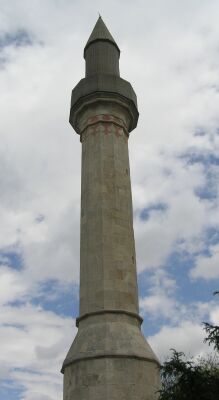Minaret
Translated by Dóra Lukács
In Érd-Ófalu, near the dam of the Danube, next to trace of the Roman military road (Mecset Street) stands the minaret of the 17th-century mosque, evoking the extinct memory of the Turkish Age. The Turkish tower, a registered monument, is the pride of everyone in Érd, for the only other minarets in the country are in Eger and Pécs. The minaret of Sultan Suleiman’s mosque is Szigetvár is maimed; it was damaged by a lightening in 1721. The minaret of the Küthida mosque of Eger, which is often described as the most graceful minaret, stands as alone as the tower in Érd. Its mosque was destroyed. One of the uniqueness of the Jakovali Hassan mosque in Pécs resides in its entirety, since the both the mosque and the minaret are intact. The minarets of the Ghazi Khasim mosque (also in Pécs) are missing.
The detailed description of Hungarian mosques and minarets was written by Molnár József in his book titled “The Relics of the Turkish World in Hungary”, with the help of which we can imagine the features of the Turkish house of worship in Érd: the rectangular building, the ornate, stone-framed door, the Mihrab (a praying booth) opposite of the entrance, carpets, colourful windows, the balcony, protected by wooden bars, where the muezzin could make his way to the tower.
The date of the mosque’s construction was placed in the 16th century for a long time, because Érd was the property of Hamza Bey of Székesfehérvár (1551-1570) between 1562 and 1563.
The Archaeological Topography of Hungary gives a detailed report about the results of the excavation lead by archaeologist Géza Fehér between 1962 and 1965, according to which the mosque was surely built in the 17th century upon the expanded foundations of the palisade fortress. The excavation showed that the fortress was 147 metres long in the north-south direction. Károly Ferenczy, taking the results of the excavation as a starting point, completed the reconstruction plan of the damaged tower in 1970 with ornate pavement indicating the size of the mosque (10 times 11 metres) and the reinforced concrete imitation of the Mihrab booth, facing towards Mecca. Pylons indicate the corners of the mosque. The missing parts of the minaret were deliberately made out of a different material (also concrete) than the original, to make it clear which parts are original and which are not. The reconstruction of the monument was done according to the Venetian Charta. The new material may be a bit rigid, but it resists the weather well.
In September 1999, during the cleansing of the front, the restorers found traces of red paint on the carved ornaments, which they reconstructed. The outside stone-conservation of the tower was finished in November 1999 with the support of the Ministry of National Cultural Heritage. There was no chance for the rebuilding of the mosque, since other than the layout, there is no base for an authentic reconstruction.
From 17th-century documents and sketchy maps, we know the environment in which the mosque was built.
The first mention of the palisade fortress is from 1569. Mustafa, Pasha of Buda mentioned it in his complaint to King Miksa: “… Those from Tata came, they snatched 700 oxen from Hamza Bey’s parkan (fortress).”
The often-quoted Turkish traveller, Evlia Cselebi came to Érd in 1663; arriving from the direction of Ercsi, he wrote: “Going north from here for four hours, we arrived to Hamza Bey’s palisade fortress. This was built by Hamza Bey, the bey of Simontornya, upon the order of Khan Suleiman. After Oglu Zerin burnt down the fortress, Ismail pasha, upon hearing that the Grand Vizier was coming on a campaign against Győr, gathered the rajas and the folks and rebuilt it. Now it has a commander and three hundred soldiers. There are twenty plank-roofed houses and a mosque in the castle.”
The 23 metres high minaret in Érd stands out among the other Hungarian towers with its stockiness. The body has a polygonal layout with twelve angles. 53 chipped steps of various heights lead up to the round balcony. The lighting of the stairs is ensured by a series of small gaps built into the walls of the tower.
Stepping out of the top door, oriented towards Mecca, we find a wonderful panorama of Ófalu, the Danube and the Beliczay Island.
